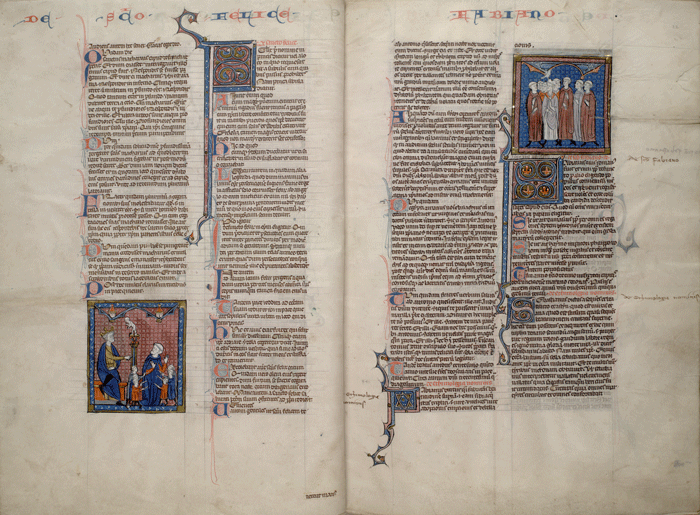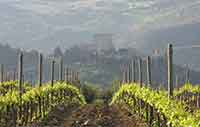| |
|
The history of the medieval illuminated book in western Europe began with the introduction of the Christian faith into those regions which had been dominated during the 5th and 6th cen- turies, the aptly named Dark Ages, by the migrating Germanic peoples. Christianity is a book-based religion, its central pivot the Four Gospels chronicling the life, death and resurrection of the Son of God. Access to a copy of this text was a fundamental requirement for every priest, both as a foundation for his teaching and as a central necessity in the performance of the liturgy. Such a book would naturally be the first to inspire decoration within and without, to provide a visual focus for the devotions of the newly faithful, most of whom would for a long time have remained illit- erate and mindful of their pagan roots. Copies of the gospels were thus for several centuries the target of the finest endeavours of illuminators. The Golden Legend is one of the central texts of the Middle Ages, a superb summary of saints' lives and religious festivals which decisively influenced the imagery of poetry. [1]
The Golden Legend (Latin: Legenda aurea or Legenda sanctorum) is a collection of hagiographies by Jacobus de Voragine that became a late medieval bestseller. It was likely compiled around the year 1260.
By creating a single-volume sourcebook of all the core Christian stories, Jacobus de Voragine (c.1229-98) attracted a huge audience right across Europe. Chaucer adapted the section on St Cecilia in his Canterbury Tales and Caxton published an expanded English version in 1483. This selection of over 70 biographies ranges from the first Apostles and Roman martyrs to near-contemporaries like St Dominic, Francis of Assisi and Princess Elizabeth of Hungary. Witnesses to the true faith withstand terrible tortures and reduce their persecutors to mockery. Reformed prostitutes win divine forgiveness, while other women live disguised as monks or nobly resist lustful tyrants. Jacobus’ book is essential reading for anyone who wants to understand medieval imagery, art and thought; this fine new translation captures both its vigour and variety.
A medieval bestseller
Initially entitled Legenda sanctorum (Readings of the Saints), it gained its popularity under the title by which it is best known. It overtook and eclipsed earlier compilations of abridged legendaria, the Abbreviatio in gestis et miraculis sanctorum attributed to Jean de Mailly and the Epilogus in gestis sanctorum of the Dominican preacher Bartholomew of Trent. Over eight hundred manuscript copies of the work survive, and when printing was invented in the 1450s, editions appeared quickly, not only in Latin, but also in every major European language. Among incunabula, printed before 1500, Legenda aurea was printed in more editions than the Bible. It was one of the first books William Caxton printed in the English language; Caxton's version appeared in 1483 and his translation was reprinted, reaching a ninth edition in 1527.
Fanciful etymologies
The book sought to compile traditional lore about all of the saints venerated at the time of its compilation. Jacobus de Voragine typically begins with an (often fanciful) etymology for the saint's name. An example (in Caxton's translation) shows his method:
"Silvester is said of sile or sol which is light, and of terra the earth, as who saith the light of the earth, that is of the church. Or Silvester is said of silvas and of trahens, that is to say he was drawing wild men and hard unto the faith. Or as it is said in glossario, Silvester is to say green, that is to wit, green in contemplation of heavenly things, and a toiler in labouring himself; he was umbrous or shadowous. That is to say he was cold and refrigate from all concupiscence of the flesh, full of boughs among the trees of heaven."
As a Latin author, Jacobus de Voragine must have known that Silvester, a relatively common Latin name, simply meant "from the forest". The correct derivation is alluded to in the text, but set out in parallel to fanciful ones that lexicographers would consider quite wide of the mark. Even the "correct" explanations (silvas, "forest", and the mention of green boughs) are used as the basis for an allegorical interpretation. Jacobus de Voragine's etymologies had different goals from modern etymologies, and cannot be judged by the same standards. Jacobus de Voragine's etymologies have parallels in Isidore of Seville's Etymologiae, in which linguistically accurate derivations are set out beside allegorical and figurative explanations.
|
|

Jacobus de Voragine, Stephen being stoned |
 |
Jacobus de Voragine, Cosmas and Damian, attaching the black leg to the sick man, Henry E. Huntington Library and Art Gallery, San Marino, California [3]
|
Lives of the saints
|
|
|
Jacobus de Voragine then moves on to the saint's life, compiled with reference to the readings from the Roman Catholic Church's liturgy commemorating that saint; then embellishes the biography with supernatural tales of incidents involving the saint's life.
Sources
A substantial portion of Jacobus' text was drawn from two epitomes of collected lives of the saints, both also arranged in the order of the liturgical year, written by members of his Dominican order: one is Jean de Mailly's lengthy Abbreviato in gestis miraculis sanctorum (Summary of the Deeds and Miracles of the Saints) and the other is Bartholomew of Trent's Epilogum in gesta sanctorum (Afterword on the Deeds of the Saints). The many extended parallels to text found in Vincent de Beauvais' Speculum historiale, the main encyclopedia that was used in the Middle Ages, are attributed by modern scholars to the two authors' common compilation of identical sources, rather than to Jacobus' reading Vincent's encyclopedia.[2] More than 130 more distant sources have been identified for the tales related of the saints in the Golden Legend, few of which have a nucleus in the New Testament itself; these hagiographic sources include apocryphal texts such as the Gospel of Nicodemus, and the histories of Gregory of Tours and John Cassian. Many of his stories have no other known source. A typical example of the sort of story related, also involving St. Silvester, shows the saint receiving miraculous instruction from Saint Peter in a vision that enables him to exorcise a dragon:
"In this time it happed that there was at Rome a dragon in a pit, which every day slew with his breath more than three hundred men. Then came the bishops of the idols unto the emperor and said unto him: O thou most holy emperor, sith the time that thou hast received Christian faith the dragon which is in yonder fosse or pit slayeth every day with his breath more than three hundred men. Then sent the emperor for S. Silvester and asked counsel of him of this matter. S. Silvester answered that by the might of God he promised to make him cease of his hurt and blessure of this people. Then S Silvester put himself to prayer, and S. Peter appeared to him and said: "Go surely to the dragon and the two priests that be with thee take in thy company, and when thou shalt come to him thou shalt say to him in this manner: Our Lord Jesu Christ which was born of the Virgin Mary, crucified, buried and arose, and now sitteth on the right side of the Father, this is he that shall come to deem and judge the living and the dead, I commend thee Sathanas that thou abide him in this place till he come. Then thou shalt bind his mouth with a thread, and seal it with thy seal , wherein is the imprint of the cross. Then thou and the two priests shall come to me whole and safe, and such bread as I shall make ready for you ye shall eat."
Thus as S. Peter had said, S. Silvester did. And when he came to the pit, he descended down one hundred and fifty steps, bearing with him two lanterns, and found the dragon, and said the words that S. Peter had said to him, and bound his mouth with the thread, and sealed it, and after returned, and as he came upward again he met with two enchanters which followed him for to see if he descended, which were almost dead of the stench of the dragon, whom he brought with him whole and sound, which anon were baptized, with a great multitude of people with them. Thus was the city of Rome delivered from double death, that was from the culture and worshipping of false idols, and from the venom of the dragon."
Voragine had his limits; he describes the story of Saint Margaret of Antioch surviving being swallowed by a dragon as "apocryphal and not to be taken seriously" (trans. Ryan, 1.369).
|
|
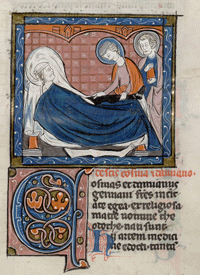
Jacobus de Voragine, Cosmas and Damian, attaching the black leg to the sick man
 Jacobus de Voragine, Anastasia being burned at the stake Jacobus de Voragine, Anastasia being burned at the stake
|
 |
| Petronilla in bed, and Felicula being tortured (left); Peter the Exorcist and Marcellinus (right)
|
Miracle tales of relics
|
|
|
Many of the stories also conclude with miracle tales and similar wonderlore from accounts of those who called upon that saint for aid or used the saint's relics. Such a tale is told of Saint Agatha; Jacobus de Voragine has pagans in Catania repairing to the relics of St. Agatha to supernaturally repel an eruption of Mount Etna:
And for to prove that she had prayed for the salvation of the country, at the beginning of February, the year after her martyrdom, there arose a great fire, and came from the mountain toward the city of Catania and burnt the earth and stones, it was so fervent. Then ran the paynims to the sepulchre of S. Agatha and took the cloth that lay upon her tomb, and held it abroad against the fire, and anon on the ninth day after, which was the day of her feast, ceased the fire as soon as it came to the cloth that they brought from her tomb, showing that our Lord kept the city from the said fire by the merits of S. Agatha.
16th-century collapse
The adverse reaction to Legenda aurea under critical scrutiny in the 16th century was led by scholars who reexamined the criteria for judging hagiographic sources and found Legenda aurea wanting; prominent among the humanists were two disciples of Erasmus, Georg Witzel, in the preface to his Hagiologium, and Juan Luis Vives in De disciplinis. Criticism among members of Jacobus' Dominican order were muted by the increased reverence towards the archbishop, which culminated in his canonization in 1815. The rehabilitation of Legenda aurea in the 20th century, now interpreted as a mirror of the heartfelt pieties of the 13th, is attributed[6] to Téodor de Wyzewa, whose retranslation into French, and its preface, have been often reprinted.
Value to students of medieval culture
Written in simple, readable Latin, the book was read in its day for its stories; any one of which will be well told, but in mass they tend to become monotonous and blur together, with their repetitious accounts of martyrdoms and miracles. The book is considered the closest to an encyclopaedia of medieval saint lore that survives today; as such it is invaluable to art historians and medievalists who seek to identify saints depicted in art by their deeds and attributes. Its repetitious nature is probably explained by the fact that Jacobus de Voragine meant to write a compendium of saintly lore for sermons and preaching, not a work of popular entertainment.
A modern English translation of the Golden Legend has been published by William Granger Ryan, ISBN 0-691-00153-7 and ISBN 0-691-00154-5 (2 volumes). The critical edition of the Latin text has been edited by Giovanni Paolo Maggioni (Florence: SISMEL 1998]. |
|
 Ressurection Ressurection
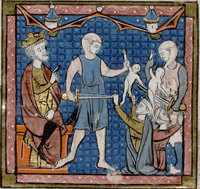 Massacre of the Innocents Massacre of the Innocents
|
|
|
|
| |
|
Illustrations from Jacobus de Voragine, Legenda aurea, Henry E. Huntington Library and Art Gallery, San Marino, California.
 |
The Golden Legend — William Caxton's Middle English version, formatted for easy reading (HTML and PDF).
The Golden Legend or Lives Of The Saints, compiled by Jacobus de Voragine, Archbishop of Genoa, 1275. Englished by William Caxton, First Edition 1483. From the Temple Classics Edited by F.S. Ellis.
Illustrations of The Golden Legend from the HM 3027 manuscript of Legenda Aurea from the Huntington Library | dpg.lib.berkeley.edu
[Jacobus de Voragine, Cosmas and Damian, attaching the black leg to the sick man, Henry E. Huntington Library and Art Gallery, San Marino, California]
The Golden Legend (Aurea Legenda), compiled by Jacobus de Voragine, 1275, Englished by William Caxton, 1483
Historians interested in the "real lives" of individual saints value the earliest texts above all others. But for assessing the later cult of saints in Western Europe the Golden Legend Jacobus de Voragine, writing about 1260, achieved dominance in later western hagiographical literature - about 900 manuscripts of his Golden Legend survive. From 1470 to 1530 it was also the most often printed book in Europe.
Thanks to the efforts of Robert Blackmon, the Medieval Sourcebook can now make available the full text of the seven volume edition published by Temple Classics in 1900. That was based on an older English translation by William Caxton, but with a text modernized by F.S. Ellis. Any notes in [square brackets] were added for this etext.
To make the text as useful as possible to readers, the Golden Legend is available here in two forms: a very large files for each of the volumes, and (eventually) by chapter. This page is the overall Index for the online version of the text.
Catholic Encyclopedia (1913) | Legends of the Saints
Piero della Francesca's The History of the True Cross

[1] Janet Backhouse, The Illuminated Page: Ten Centuries of Manuscript Painting in the British Library, British Library, London, 1997
[1b] The Golden Legend is one of the central texts of the Middle Ages, a superb summary of saints’ lives and religious festivals which decisively influenced the imagery of poetry, painting and stained glass.
An introduction to the Legenda, its great popular late medieval success and the collapse of its reputation in the 16th century, is Sherry L. Reames, The Legenda Aurea: a reexamination of its paradoxical history, (University of Wisconsin) 1985.
[2] Christopher Stace, tr., The Golden Legend: selections' (Penguin), "Introduction" pp xii-xvi, reporting conclusions of K. Ernest Geith, (Geith, "Jacques de Voragine, auteur indépendant ou compilateur?" in Brenda Dunn-Lardeau, ed. Legenda aurea - 'La Légende dorée 1993:17-32) who printed the comparable texts side by side.
[3] The scene represents the miraculous substitution of a diseased leg by a healthy one on the patient in the foreground. According to legend the saints amputated a white man’s leg while he slept and replaced it by that of a black Ethiopian (or Moor).
The saints, in the act of attaching the black leg to the sleeping man, are depicted in the painting by Fra Angelico (circa 1438) in the Museo di San Marco, Florence; in that of the sixteenth century Spaniard Fernando del Rincon where the corpse of the black donor is shown in the foreground; in a miniature painting ascribed to Andrea Mantegna (15th century) where the amputated leg is seen on the floor, and in a work by Alonso de Sedano (active 1496) in Burgos Cathedral.
The San Marco Altarpiece, housed in the San Marco Museum of Florence, represents the Virgin with Saints Cosmas and Damian (the patrons of the Medici family), Dominic, Peter, Francis, Mark, John Evangelist and Stephen; the pediment illustrated the lives of Cosmas and Damian, but it has long been severed from the main subject.
Apart from St. Luke, Saints Cosmas and Damian are the earliest Christians to have been medical men. They were twin brothers born in Aegea (Arabia) in the 3rd century A.D. They practised medicine in Cilicia (Asia Minor) where they gained renown for their successful treatments, their holiness and their generosity; in fact, it is said, they accepted no fees for their professional work.
They suffered martyrdom for their Christian faith during the reign of Emperor Diocletian on September 27th. The year is uncertain being variously given between 283 A.D. and 303 A.D. From Syria (Cyrus), where they were buried, their cult reached Constantinople in the 4th century and subsequently spread to Italy, Germany, France and Spain. Some of their remains were transferred to Rome and Venice. Their names were introduced in the Canon of the Mass about the 6th century.
Since early times Saints Cosmas and Damian have been regarded, together with St. Luke, as the patron saints of physicians, surgeons and pharmacists. They have also been the object of popular veneration in various parts of the world. Great painters have, since the time of Fra Angelico (Giovanni da Fiesole 1387-1455), portrayed the two saints in various guises.
In the Maltese Islands the veneration of the two saints found expression in the erection of a church in Gozo, the dedication of several altars in various churches, the foundation of a hospital, the naming of hospital [p.26] wards, the production of paintings and statues, the veneration of relics and the formulation of prayers. [The Cult and Iconography of Saints Cosmas and Damian in the Maltese Islands]
|
|
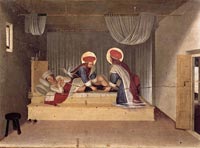 Fra Angelico, Predella of San Marco Altarpiece, The Healing of Justinian by Saint Cosmas and Saint Damian, Museo di San Marco, Florence Fra Angelico, Predella of San Marco Altarpiece, The Healing of Justinian by Saint Cosmas and Saint Damian, Museo di San Marco, Florence
|
 |
Detail of a miniature of Anthony being tormented by demons, with an historiated initial 'A'(nthoine) of Anthony being blessed by another saint, at the beginning of his legend. France, Central and N. W. (Paris and Rouen). Saint Anthony and the lobster devil. Jacobus de Voragine, La Légende Dorée (Legenda aurea), France 1470. British Library, Yates Thompson 49 vol. 1, fol. 34.
Related to the Coëtivy Master. [See also: www.bl.uk/]
|


The ultimate Italy Villa Rental. Podere Santa Pia, a formal cloister in the Tuscan Maremma with a view made in heaven is the perfect holiday resort for relaxing and enjoying the splendor of the Maremma hills of southern Tuscany.
Artist and writer's residency | Holiday houses in Tuscany | Podere Santa Pia
|
|
|
|
|
|
| Wine regions |
|
Podere Santa Pia |
|
Podere Santa Pia, view from the garden on the valley below
|
| |
|
|
|
|
This page incorporates text from the article Legends of the Saints, (Catholic Encyclopedia. New York: Robert Appleton Company. 1913), a publication now in the public domain, and uses material from the Wikipedia articles Golden Legend, Saints of the Golden Legend, published under the GNU Free Documentation License.
Wikimedia Commons has media related to: Golden Legend |
|
|
